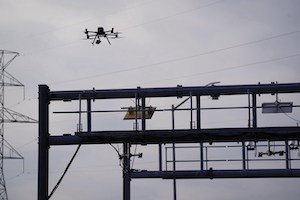407 ETR to test drone technology for overhead structure inspections
The consortium that owns Highway 407 is partnering with Mohawk College on an initiative designed to improve workplace safety.
 407 ETR announced a test project with the college's Unmanned and Remote Sensing Innovation Centre (URSIC) to deploy drones to conducting visual inspections of overhead structures such as signs and gantries.
407 ETR announced a test project with the college's Unmanned and Remote Sensing Innovation Centre (URSIC) to deploy drones to conducting visual inspections of overhead structures such as signs and gantries.
Currently, inspectors must physically climb overhead gantries to perform manual inspections while traffic passes underneath.
The project began last October and will soon expand to other applications including bridges and stormwater ponds. Through this work, 407 ETR also hopes to identify whether drone technology can operate in winter. Inspections are usually conducted in warmer seasons to mitigate hazards associated with winter weather conditions.
Highway 407 ETR has 236 bridges, 204 gantry systems (plate and transponder readers) and 230 overhead signs. The organization expects to complete over 150 manual overhead sign and gantry inspections in 2023.
"Although we're extremely proud of our strong safety culture, there are inherent dangers that workers are exposed to when inspecting overhead signs. To conduct these inspections, they are at a significant height over live traffic," said Tony Angelo, Director of Bridges at 407 ETR. "I'm optimistic the research done with Mohawk College will result in new and innovative ways of doing this work more safely."
Highway 407 ETR is an all-electronic open-access toll highway located in the Greater Toronto Area. It spans 108 kilometres from Burlington in the west to Pickering in the east.
Its ownership group comprises the Canada Pension Plan Investment Board, Cintra Global S.E., a subsidiary of Ferrovial S.A., and SNC-Lavalin.
In March, 407 ETR celebrated 3 million hours without a lost time injury.








